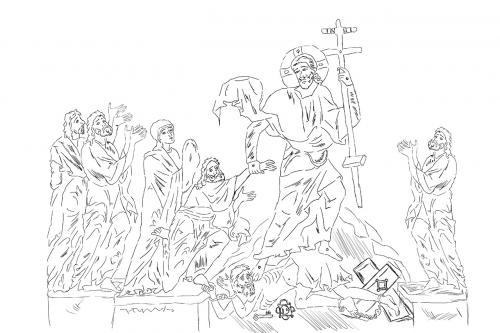



The Descent to Hell
The primary sources of the iconographical theme "The Descent to Hell" are to be found in the epistles of 1 Peter (3:18-19. 19:4-6) and 1 Corinthians (15:6-28. 15:45), dealing with the subjects of Gospel preaching to the souls of the dead and the defeated Death.
The background of the typical representations is suggesting the sky. Curved rocks, placed on one or both sides of the image, are adding to the impression of depth and sinking. The Hell is imagined as a dark, cold realm, where the souls of those dead before the Coming of Christ are suffering from the lack of the joy caused by His presence. The souls of the sinners are inhabiting the Gehenna, a level which, canonically, is placed under that of the Hell. The rocky soil Jesus is treading on is the level of the Hell, its shattered gates being at or under Jesus' feet, sometimes displayed in the form of St. Andrew's cross and covering the entrance to the Gehenna. Gehhena, sunk in complete obscurity, is depicted as a black background over which keys, locks, nails and broken chains may appear. In more complex variants, the defeated Death is shown as a demon with tied hands and legs. Jesus is surrounded by a variable number of souls of the dead. Always, at His right side, in the foreground, Adam and Eve are represented extending their hands towards Jesus, Eve's hands covered, out of respect, by her mantle. Traditionally, although not mandatory, Adam, sometimes Eve also, is raising from a rectangular sarcophagus towards Jesus' hand who draws Adam towards Him, as a sign of redemption. Under the influence of the Russian School, in Post-Byzantine modern art, the protoparents are represented kneeling on each side of Christ, Adam on His right, while He is holding their hands.
The primary sources of the iconographical theme "The Descent to Hell" are to be found in the epistles of 1 Peter (3:18-19. 19:4-6) and 1 Corinthians (15:6-28. 15:45), dealing with the subjects of Gospel preaching to the souls of the dead and the defeated Death.
The background of the typical representations is suggesting the sky. Curved rocks, placed on one or both sides of the image, are adding to the impression of depth and sinking. The Hell is imagined as a dark, cold realm, where the souls of those dead before the Coming of Christ are suffering from the lack of the joy caused by His presence. The souls of the sinners are inhabiting the Gehenna, a level which, canonically, is placed under that of the Hell. The rocky soil Jesus is treading on is the level of the Hell, its shattered gates being at or under Jesus' feet, sometimes displayed in the form of St. Andrew's cross and covering the entrance to the Gehenna. Gehhena, sunk in complete obscurity, is depicted as a black background over which keys, locks, nails and broken chains may appear. In more complex variants, the defeated Death is shown as a demon with tied hands and legs. Jesus is surrounded by a variable number of souls of the dead. Always, at His right side, in the foreground, Adam and Eve are represented extending their hands towards Jesus, Eve's hands covered, out of respect, by her mantle. Traditionally, although not mandatory, Adam, sometimes Eve also, is raising from a rectangular sarcophagus towards Jesus' hand who draws Adam towards Him, as a sign of redemption. Under the influence of the Russian School, in Post-Byzantine modern art, the protoparents are represented kneeling on each side of Christ, Adam on His right, while He is holding their hands.




